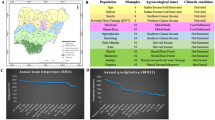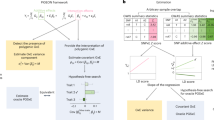Abstract
African pygmies are at the lower extreme of human variation in adult stature and many evolutionary hypotheses have been proposed to explain this phenotype. We showed in a recent study that the difference in average stature of about 10 cm observed between contemporary pygmies and neighboring non-pygmies has a genetic component. Nevertheless, the genetic basis of African pygmies’ short stature remains unknown. Using a candidate-gene approach, we show that intronic polymorphisms in GH receptor (GHR) and insulin-like growth factor 1 (IGF1) genes present outlying values of the genetic distance between Baka pygmies and their non-pygmy Nzimé neighbors. We further show that GHR and IGF1 genes have experienced divergent natural selection pressures between pygmies and non-pygmies throughout evolution. In addition, these SNPs are associated with stature in a sample composed of 60 pygmies and 30 non-pygmies and this association remains significant when correcting for population structure for the GHR locus. We conclude that the GHR and IGF1 genes may have a role in African pygmies’ short stature. The use of phenotypically contrasted populations is a promising strategy to identify new variants associated with complex traits in humans.
Similar content being viewed by others
Log in or create a free account to read this content
Gain free access to this article, as well as selected content from this journal and more on nature.com
or
References
Froment A : Biological variation and adaptation in humans: the case of African pygmies. Bull Mém Soc Anthropol Paris 1993; 5: 417–448.
Verdu P, Austerlitz F, Estoup A et al: Origins and genetic diversity of pygmy hunter-gatherers from Western Central Africa. Curr Biol 2009; 19: 312–318.
Patin E, Laval G, Barreiro LB et al: Inferring the demographic history of African farmers and pygmy hunter-gatherers using a multilocus resequencing data set. PLoS Genet 2009; 5: e1000448.
Perry GH, Dominy NJ : Evolution of the human pygmy phenotype. Trends Ecol Evol 2009; 24: 218–225.
Bailey RC, Head G, Tenike M et al: Hunting and gathering in tropical rainforest: is it possible? Am Anthropol 1989; 91: 59–82.
Cavalli-Sforza LL : African Pygmies. London: Academic Press, 1986.
Diamond JM : Why are pygmies small? Nature 1991; 354: 111–112.
Walker R, Gurven M, Hill K et al: Growth rates and life histories in twenty-two small-scale societies. Am J Hum Biol 2006; 18: 295–311.
Migliano AB, Vinicius L, Lahr MM : Life history trade-offs explain the evolution of human pygmies. Proc Natl Acad Sci USA 2007; 104: 216–219.
Becker NSA, Touraille P, Froment A et al: Short stature in African pygmies is not explained by sexual selection. Evol Hum Behav 2012, advanced publication online.
Becker NSA, Verdu P, Hewlett B : Can life history trade-offs explain the evolution of short stature in human pygmies? A response to Migliano et al. (2007). Hum Biol 2010; 82: 17–27.
Becker NS, Verdu P, Froment A et al: Indirect evidence for the genetic determination of short stature in African pygmies. Am J Phys Anthropol 2011; 145: 390–401.
Rimoin DL, Merimee TJ, Rabinowitz D et al: Peripheral subresponsiveness to human growth hormone in the African pygmies. N Engl J Med 1969; 281: 1383–1388.
Merimee TJ, Rimoin DL, Cavalli-Sforza LL : Metabolic studies in the African pygmy. J Clin Invest 1972; 51: 395–401.
Merimee TJ, Zapf J, Froesch ER : Dwarfism in the pygmy. An isolated deficiency of insulin-like growth factor I. N Engl J Med 1981; 305: 965–968.
Merimee TJ, Zapf J, Hewlett B et al: Insulin-like growth factors in pygmies. The role of puberty in determining final stature. N Engl J Med 1987; 316: 906–911.
Baumann G, Shaw MA, Merimee TJ : Low levels of highaffinity growth hormone-binding protein in African pygmies. N Engl J Med 1989; 320: 1705–1709.
Bozzola M, Travaglino P, Marziliano N et al: The shortness of pygmies is associated with severe under-expression of the growth hormone receptor. Mol Genet Metab 2009; 98: 310–313.
Hardouin S, Gourmelen M, Noguiez P et al: Molecular forms of serum insulin-like growth factor (IGF)-binding proteins in man: relationships with growth hormone and IGFs and physiological significance. J Clin Endocrinol Metab 1989; 69: 1291–1301.
Bowcock A, Sartorelli V : Polymorphism and mapping of the IGF1 gene, and absence of association with stature among African pygmies. Hum Genet 1990; 85: 349–354.
Schneid H, Le Bouc Y, Seurin D et al: Insulin-like growth factor-I gene analysis in subjects with constitutionally variant stature. Pediatr Res 1990; 27: 488–491.
Jarvis JP, Scheinfeldt LB, Soi S et al: Patterns of ancestry, signatures of natural selection, and genetic association with stature in Western African pygmies. PLoS Genet 2012; 8: e1002641.
Lopez-Bermejo A, Buckway CK, Rosenfeld RG : Genetic defects of the growth hormone-insulin-like growth factor axis. Trends Endocrinol Metab 2000; 11: 39–49.
Walenkamp MJ, Wit JM : Genetic disorders in the growth hormone – insulin-like growth factor-I axis. Horm Res 2006; 66: 221–230.
Weiner JS, Lourie JA : Practical Human Biology. London; New York: Academic Press, 1981,, p 439.
Rozen S, Skaletsky H : Primer3 on the WWW for general users and for biologist programmers; in Krawetz S, Misener S, (eds): Bioinformatics Methods and Protocols: Methods in Molecular Biology. Totowa: Humana Press, 2000, pp 365–386.
Amselem S, Duquesnoy P, Attree O et al: Laron dwarfism and mutations of the growth hormone-receptor gene. N Engl J Med 1989; 321: 989–995.
Pantel J, Machinis K, Sobrier ML, Duquesnoy P, Goossens M, Amselem S : Species-specific alternative splice mimicry at the growth hormone receptor locus revealed by the lineage of retroelements during primate evolution. J Biol Chem 2000; 275: 18664–18669.
Takahashi M, Matsuda F, Margetic N, Lathrop M : Automated identification of single nucleotide polymorphism from sequencing data. J Bioinform Comput Biol 2003; 1: 253–265.
Stephens M, Scheet P : Accounting for decay of linkage disequilibrium in haplotype inference and missing-data imputation. Am J Hum Genet 2005; 76: 449–462.
Stephens M, Smith NJ, Donnelly P : A new statistical method for haplotype reconstruction from population data. Am J Hum Genet 2001; 68: 978–989.
Rozas J, Sanchez-DelBarrio JC, Messeguer X, Rozas R : DnaSP, DNA polymorphism analyses by the coalescent and other methods. Bioinformatics 2003; 19: 2496–2497.
Excoffier L, Laval G, Schneider S : Arlequin ver. 3.0: an integrated software package for population genetics data analysis. Evol Bioinform Online 2005; 1: 47–50.
Nei M : Molecular Evolutionary Genetics. New York: Columbia University Press, 1987.
Weir BS, Cockerham CC : Estimating F-statistics for the analysis of population structure. Evolution 1984; 38: 1358–1370.
Beaumont MA, Nichols RA : Evaluating loci for use in the genetic analysis of population structure. Proc R Soc Lon 1996; 263: 1619–1626.
Segurel L, Lafosse S, Heyer E, Vitalis R : Frequency of the AGT Pro11Leu polymorphism in humans: does diet matter? Ann Hum Genet 2010; 74: 57–64.
Tajima F : Statistical method for testing the neutral mutation hypothesis by DNA polymorphism. Genetics 1989; 123: 585–595.
Fu YX : Statistical tests of neutrality of mutations against population growth, hitchhiking and background selection. Genetics 1997; 147: 915–925.
Fu YX, Li WH : Statistical tests of neutrality of mutations. Genetics 1993; 133: 693–709.
Fay J, Wu C : Hitchhiking under positive Darwinian selection. Genetics 2000; 155: 1405–1413.
R Development Core Team: R: A Language and Environment for Statistical Computing. Vienna, Austria: R Foundation for Statistical Computing, 2008.
Thomas DC, Witte JS : Point: population stratification: a problem for case-control studies of candidate-gene associations? Cancer Epidemiol Biomarkers Prev 2002; 11: 505–512.
Falush D, Stephens M, Pritchard JK : Inference of population structure using multilocus genotype data: linked loci and correlated allele frequencies. Genetics 2003; 164: 1567–1587.
Pritchard JK, Stephens M, Donnelly P : Inference of population structure using multilocus genotype data. Genetics 2000; 155: 945–959.
Rosenberg NA, Pritchard JK, Weber JL et al: Genetic structure of human populations. Science 2002; 298: 2381–2385.
Dos Santos C, Essioux L, Teinturier C, Tauber M, Goffin V, Bougneres P : A common polymorphism of the growth hormone receptor is associated with increased responsiveness to growth hormone. Nat Genet 2004; 36: 720–724.
Wassenaar MJ, Dekkers OM, Pereira AM et al: Impact of the exon 3-deleted growth hormone (GH) receptor polymorphism on baseline height and the growth response to recombinant human GH therapy in GH-deficient (GHD) and non-GHD children with short stature: a systematic review and meta-analysis. J Clin Endocrinol Metab 2009; 94: 3721–3730.
Cavalli-Sforza L : Population structure and human evolution. Proc R Soc Lond B Biol Sci 1966; 164: 362–379.
Nielsen R : Molecular signatures of natural selection. Annu Rev Genet 2005; 39: 197–218.
Cardon LR, Palmer LJ : Population stratification and spurious allelic association. Lancet 2003; 361: 598–604.
Hamer D, Sirota L : Beware the chopsticks gene. Mol Psychiatry 2000; 5: 11–13.
Cann HM, de Toma C, Cazes L et al: A human genome diversity cell line panel. Science 2002; 296: 261–262.
Hill WG, Robertson A : Linkage disequilibrium in finite populations. Theor Appl Genet 1968; 38: 226–231.
Schneid H, Seurin D, Le Bouc Y : Pathology of the growth and abnormalities of IGF genes. Ann Endocrinol-Paris 1991; 52: 479–482.
Frazer K, Ballinger D, Cox D et al: A second generation human haplotype map of over 3.1 million SNPs. Nature 2007; 449: 851–861.
Lango Allen H, Estrada K, Lettre G et al: Hundreds of variants clustered in genomic loci and biological pathways affect human height. Nature 2010; 467: 832–838.
Hiernaux J : Long-term biological effects of human migration from the African savanna to the equatorial forest: a case study of human adaptation to a hot and wet climate; in Harrisson GA, (ed.): Population Structure and Human Variation. Cambridge: Cambridge University Press, 1977.
Ruff CB : Climatic adaptation and hominid evolution: the thermoregulatory imperative. Evol Anthropol 1993; 2: 53–60.
Schreider E : Morphological variations and climatic differences. J Hum Evol 1975; 4: 529–539.
Eggert MKH : The Bantu problem and African archaeology; in Stahl AB, (ed.): African Archaeology. Oxford: Blackwell, 2005, pp 301–326.
Acknowledgements
We warmly thank all individuals who participated in the study, as well as Frédéric Austerlitz, Serge Bahuchet, Sylvie Le Bomin and Etienne Patin for useful comments and advice, Renaud Vitalis for help with the modified version of the Dfdist software and Friso Palstra for proofreading. This work was supported by Assistance Publique Hôpitaux de Paris, ATM-MNHN: ‘Les relations Sociétés-Natures dans le long terme’ 2009–2012, the Fondation pour la Recherche Médicale and the ANR-Blanc program ‘GrowingAP’.
Author information
Authors and Affiliations
Corresponding author
Ethics declarations
Competing interests
The authors declare no conflict of interest.
Additional information
Supplementary Information accompanies the paper on European Journal of Human Genetics website
Supplementary information
Rights and permissions
About this article
Cite this article
Becker, N., Verdu, P., Georges, M. et al. The role of GHR and IGF1 genes in the genetic determination of African pygmies’ short stature. Eur J Hum Genet 21, 653–658 (2013). https://doi.org/10.1038/ejhg.2012.223
Received:
Revised:
Accepted:
Published:
Issue date:
DOI: https://doi.org/10.1038/ejhg.2012.223
Keywords
This article is cited by
-
Morphological variation of the deciduous second molars in the Baka Pygmies
Scientific Reports (2021)
-
The same growth pattern from puberty suggests that modern human diversity results from changes during pre-pubertal development
Scientific Reports (2021)
-
Complex Phenotypes: Mechanisms Underlying Variation in Human Stature
Current Osteoporosis Reports (2019)
-
A genome scan for genes underlying adult body size differences between Central African hunter-gatherers and farmers
Human Genetics (2018)
-
Diversity in tooth eruption and life history in humans: illustration from a Pygmy population
Scientific Reports (2016)



